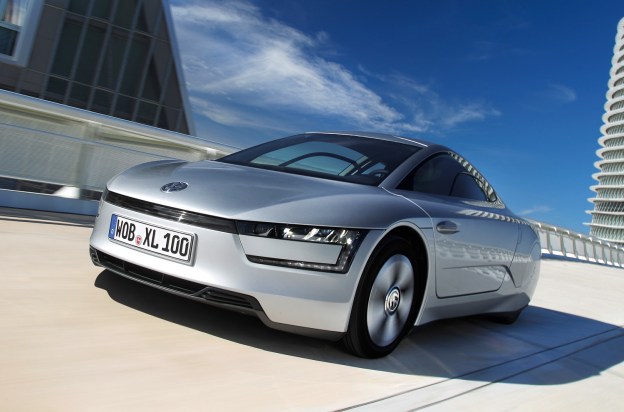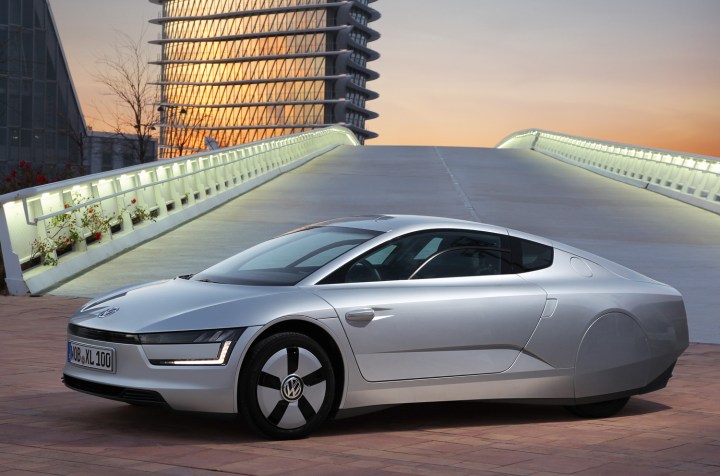
In the early 2000s, Dr. Professor Ferdinand Piëch – now Chairman of the Supervisory Board of Volkswagen AG – dreamed of a car that could achieve a fuel economy rating of one liter per 100 kilometers traveled. While some thought he was mad, it was this idea that spawned the project that would give rise to the XL1: the most fuel-efficient production car in the world.
The Car
The production XL1 represents the third generation of the highly fuel-efficient one-liter concept conceived by Piëch. In fact, the XL1 exceeds the fuel-efficiency goal by achieving 0.9 liters per 100 km or 261 miles per gallon. Achieving this goal took nearly twelve years and hundreds of thousands of man hours. In order to complete the daunting task, Volkswagen engineers had to develop dozens of new technologies both in drivetrain efficiencies and vehicle body construction.

The XL1 is built in a handcrafted-like method in Volkswagen’s Osnabrück plant in Germany. The dolphin-like two-seater, which is constructed from a revolutionary material called carbon fiber reinforced polymer (CFRP), is powered by a 0.8-liter two-cylinder TDI diesel plug-in hybrid system.
The Body
The ultra lightweight XL1 weighs only 1752 pounds and stands as the most aerodynamic production car in the world with a drag coefficient of 0.189. To put that in perspective, the Mercedes-Benz CLA, which is the next most aerodynamic production car, has a drag coefficient of 0.23. Intentionally, designers formed the XL1 to resemble a dolphin.
Volkswagen designers made sure the XL1 was not only very slippery while traveling through the air but also exceptionally striking to behold. Bodyline details were sculpted to be aerodynamic, efficient, and also aesthetically pleasing. To that end, Volkswagen installed wing doors on the XL1 to highlight its futuristic looks.

Additionaly, Volkswagen replaced the standard side-view mirrors with digital video cameras – called E-Mirrors – mounted in the wing doors. The E-Mirrors send images to displays inside the cabin.
The Carbon fiber reinforced polymer (CFRP) that comprises 21.3 percent of the XL1 is produced through a technique called resin transfer molding. The CFRP is formed in multi-shell, heated and cooled vacuum-sealed machinery. Liquid resin is injected at high pressure into the machine containing semi-finished carbon material. The result is CFRP.
…Capable of a 99 mile per hour top speed. It will go 0-62 mph in 12.7 seconds.
Two aluminum structures have been designed into the XL1, one in the front and one in the rear. The front aluminum skeleton cradles the 5.5-kilo-Watt-hour lithium-ion battery. In the rear, the aluminum structure holds the drivetrain and drive gear. These structures have been designed to absorb collision impact in the case of an accident, protecting the passengers. The XL1 offers passengers, as Volkswagen puts it, “necessary survival space.”
Protecting passengers further, aluminum impact beams have been installed in each door. Should the XL1 roll over and land on its roof, engineers included pyrotechnic screws in the wing doors that will detonate, allowing for an easy exit.

While able to comfortably seat two passengers, the XL1 is very petite. It’s only 12.7 feet long, 5.4 feet wide, and 3.7 feet tall. To put that in perspective, the purpose-built Porsche Boxster sports car is five inches taller than the XL1.
In previous iterations of the XL1, such as the L1 from several years ago, passengers sat in a tandem layout. In the XL1, however, they sit side-by-side, slightly graduated. As you can see from the photos, the interior of the XL1 closely resembles that of current Volkswagen offerings but with a more sparse, futuristic feel.
The Drivetrain
Although Dr. Professor Ferdinand Piëch had envisioned a 1.0-liter car, engineers were actually able to create a 0.8-liter two-cylinder TDI diesel engine for the XL1 by modifying an existing Volkswagen 1.6-liter four-cylinder TDI diesel engine. The diesel motor is mated to a seven-speed DSG dual-clutch transmission with an electric motor and clutch unit in between.
The 20 kW electric motor converts electricity from the 5.5 kWh battery pack from DC to AC, which is used to power the rear wheels. A standard 12-volt DC battery runs the accessories.

Improving efficiency and diminishing emissions further, designers added special recesses in the TDI pistons, allowing for multiple diesel injection. The XL1 emits only 21 grams of CO2 per kilometer, which exceptionally low.
Drivers can choose to operate the XL1 in electric-only mode for up to 32 miles, provided the plug-in battery system is fully charged. When the electric energy is depleted and the TDI engine needs to be started, the XL1 is able to engage the diesel engine virtually seamlessly with what Volkswagen calls “pulse starting.”

Pulse starting works by speeding up the electric motor rotor up and engaging the clutch between it and the TDI engine, thereby starting the diesel engine. While this might be hard to picture, the result is jolt-free engine starting. This allows the XL1 to stop and start the TDI as needed without disturbing the passengers.
The XL1 is capable of a 99 mile per hour top speed. It will go 0-62 mph in 12.7 seconds. When it’s reached 62 mph, impressively, the XL1 will only use 8.3 horsepower. All told, the XL1 has been rated to achieve a mind-boggling 261-mpg combined fuel-economy score.
The Impact
Volkswagen will only build a select few of the XL1s for an even more selective buyer market. Sadly, the U.S. will not be one of the XL1’s markets. When it does go on sale in Europe, though, industry experts anticipate the XL1 will carry a $40,000 to $67,000 price tag. This might seem a bit steep to some, but we think it’s a small price to pay to have a piece of motoring history, especially on that is so extraordinary to behold and fuel-efficient.
More importantly, Volkswagen will be able to take what it learned from the XL1 drivetrain and body structure and implement it into other future vehicles. In fact, it’s already planned a version of its city car, the “Up,” with the drivetrain from the XL1. With an XL1-powered Up, buyers could easily achieve an estimated 250 mpg. Just like the XL1, though; the Up is not yet scheduled to be sold Stateside.







